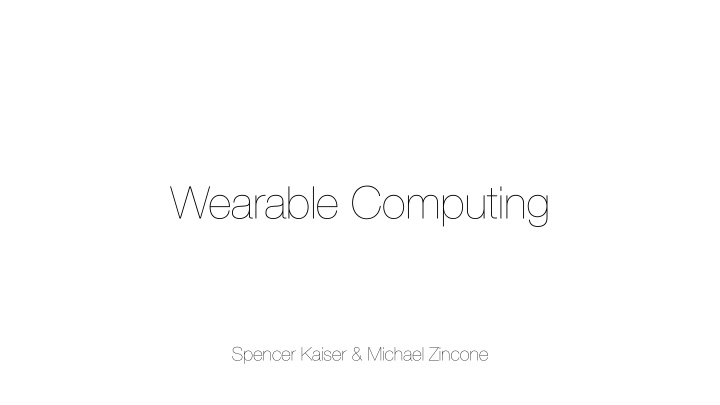



Wearable Computing Spencer Kaiser & Michael Zincone
The Evolution of Wearable Computing
The Past MIThrill WearARM Itsy MIT Lizzy Xybernaut (MIT) (ETH Zurich) (Compaq) 1981 1991 1994 2001 2003 1990 1993 2000 2002 2004 Backpack- Hip-PC Brick Computer Mounted (Doug Platt) (Panasonic) Computer (Steve Mann) Linux Watch Private Eye Half Keyboard Tinmith Q-Belt Integrated Computer (IBM) (Thad Starner) (Edgar Matias) (University of South Australia) (ETH Wearable Group)
The Present (2004-2009) ‣ Explosion in Smartphone Performance OQO (2004) and Functionality ‣ Wearable Research Adopting Smartphone ‣ Long-term Sensor Data Collection Zypad WL1100 (2007) ‣ Activity Recognition Applications
Google Glass Google (2013) Warby Parker (2014)
Smart Watches IBM Linux Watch (2000) Apple iWatch (2015) Samsung Galaxy Gear (2013)
Steve Mann Designs 1981 Mid-1980’s Early-1990’s Mid-1990’s Late 1990’s
The Future ‣ Mobile Phone-like Device ‣ Central on-body platform for general purpose computing tasks ‣ Carry-on Peripherals ‣ Microsensors Embedded in Accessories ‣ Sensing, Communication, and Power Generation Infrastructure Implemented in Textile Technology
Discussion
Will there be a point in the future where advancements in smartphone technology render wearable computing obsolete?
Will narrowly-focused wearables (e.g., Nike+) ever be completely replaced by smartphones and smartwatches?
Do OS-specific (iOS/Android) smartwatches have a negative impact on the industry as a whole?
Is there a correlation between perceived usefulness and the ease-of-use of a wearable device?
Will the smartwatch continue to gain traction as a technology or will it fizzle out?
Duet
Existing Smartwatch Interactions & Usage Watch in Foreground Watch in Background Watch used as a “ viewport ” or Both the smartphone and the remote to access an smartwatch as used for context smartphone, which was essentially an “ inactivated and activity sensing alone information portal ”
What makes Duet different? “In conversations between three or more persons, two of them may undertake jointly to carry out the communicative task to a third in such a way that a written version of their resultant in-sequence text would be indistinguishable from that of a single speaker.”
In Other Words… By simultaneously blending the interaction of a smartwatch with that of a smartphone, the overall experience is unified and the output appears to come from a single source
Existing Smartwatch Interactions & Usage Watch in Foreground Watch in Background The smartphone is used as a The smartphone is still used as primary input and output a primary input and output platform , however, the watch is platform , the smartwatch is used as an extended display used as a sensor or an input device
Duet Interactions
Watch Background Watch Foreground Finger Posture Swiping from Watch Recognition (Pad/ to Device Side/Knuckle) Swiping from Device Double Bump to Watch Hold and Flip Pinching in from both devices Flip and Tap Pinching out from Handedness both devices
Watch Background
Finger Posture Recognition
Knuckle Drag
Double Bump
Hold & Flip
Flip & Tap
Watch Foreground
Pinch
Tool Pallet
Swipe (Device to Watch)
Swipe (Watch to Device)
Utility & Practicality
Watch Foreground Are they practical and would Are these interactions useful ? they be used naturally ?
Potential Drawbacks For many interactions, the smartwatch must face the user. Would changing the orientation of the watch be irritating ?
Watch Background Are they practical and would Are these interactions useful ? they be used naturally ?
Discussion
Does the application style of duet seem like something that is more marketable than a traditional wearable?
How can either the combination of gestures or what they represent be changed to make the gestures and more intuitive?
Will the gestures and interactions presented by the Duet ever make it to market?
Recommend
More recommend